p.121
p.128
p.135
p.141
p.146
p.156
p.166
p.173
p.183
Analysis of the Effects of Mortar Thickness and Wall Building Technique in Masonry Structures Using an Anisotropic Model
Abstract:
The aim of this study is to investigate the effect of mortar/unit thickness ratio and unit configuration on the masonry wall behaviour and on masonry structure modelling. Firstly, five wall models with different mortar/unit thickness ratios and with different sizes of units are micro-modelled by using SAP2000 software. The results of these walls are used to obtain the material properties of anisotropic macro-models in vertical and horizontal directions. Secondly, a sample unreinforced masonry structure is simulated by the same software using anisotropic material properties. Earthquake loading is applied following the Turkish seismic code. Responses of these five structure models are compared with each other and also with their isotropic modelled counterparts. It is observed that isotropic modelling overestimates the rigidity of the structure around 3-5% for low mortar/unit thickness ratios, but underestimates the rigidity around 5-7% for high mortar/unit thickness ratios
Info:
Periodical:
Pages:
146-155
Citation:
Online since:
July 2016
Authors:
Price:
Сopyright:
© 2016 Trans Tech Publications Ltd. All Rights Reserved
Share:
Citation:


